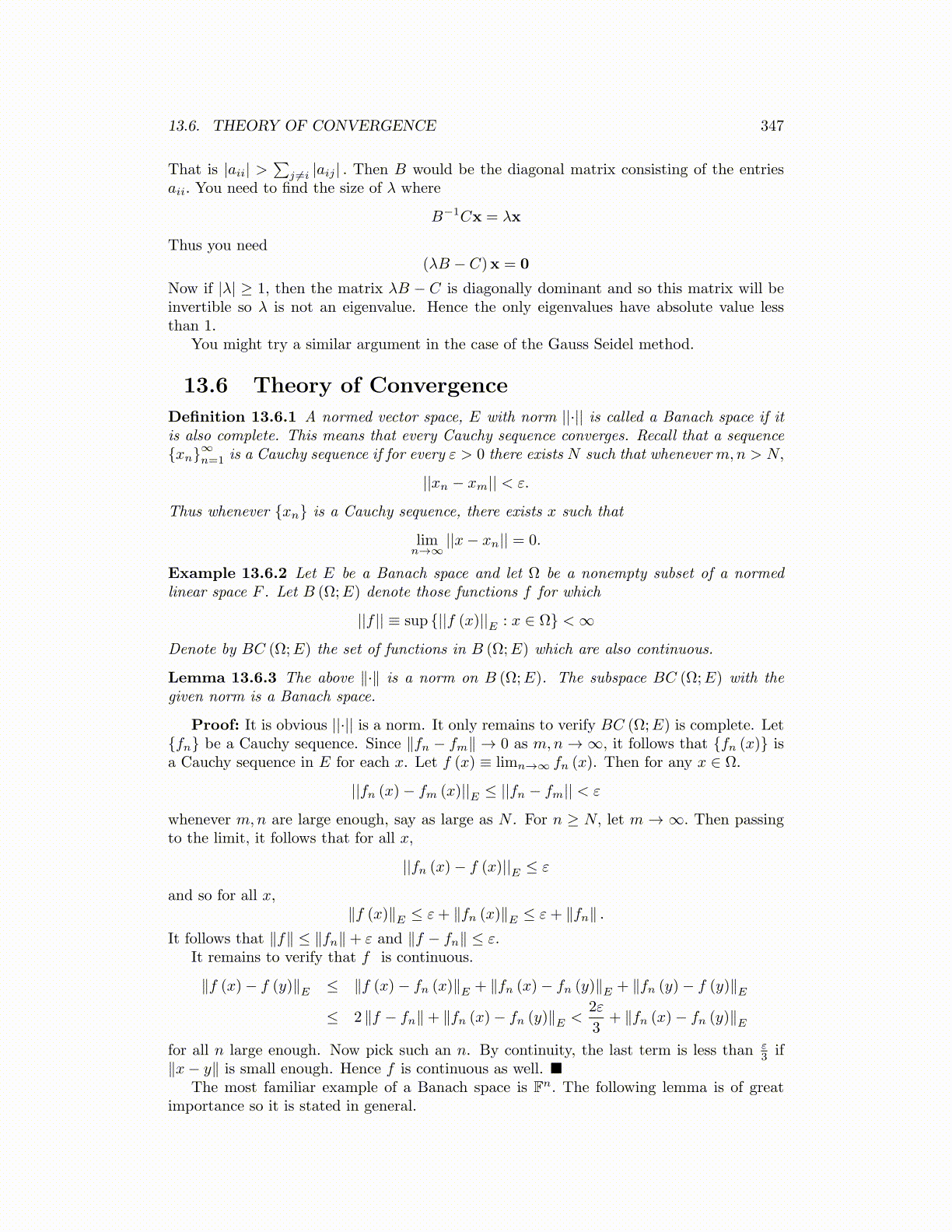
13.6. THEORY OF CONVERGENCE 347
That is |aii| >∑
j ̸=i |aij | . Then B would be the diagonal matrix consisting of the entriesaii. You need to find the size of λ where
B−1Cx = λx
Thus you need(λB − C)x = 0
Now if |λ| ≥ 1, then the matrix λB − C is diagonally dominant and so this matrix will beinvertible so λ is not an eigenvalue. Hence the only eigenvalues have absolute value lessthan 1.
You might try a similar argument in the case of the Gauss Seidel method.
13.6 Theory of Convergence
Definition 13.6.1 A normed vector space, E with norm ||·|| is called a Banach space if itis also complete. This means that every Cauchy sequence converges. Recall that a sequence{xn}∞n=1 is a Cauchy sequence if for every ε > 0 there exists N such that whenever m,n > N,
||xn − xm|| < ε.
Thus whenever {xn} is a Cauchy sequence, there exists x such that
limn→∞
||x− xn|| = 0.
Example 13.6.2 Let E be a Banach space and let Ω be a nonempty subset of a normedlinear space F . Let B (Ω;E) denote those functions f for which
||f || ≡ sup {||f (x)||E : x ∈ Ω} <∞
Denote by BC (Ω;E) the set of functions in B (Ω;E) which are also continuous.
Lemma 13.6.3 The above ∥·∥ is a norm on B (Ω;E). The subspace BC (Ω;E) with thegiven norm is a Banach space.
Proof: It is obvious ||·|| is a norm. It only remains to verify BC (Ω;E) is complete. Let{fn} be a Cauchy sequence. Since ∥fn − fm∥ → 0 as m,n → ∞, it follows that {fn (x)} isa Cauchy sequence in E for each x. Let f (x) ≡ limn→∞ fn (x). Then for any x ∈ Ω.
||fn (x)− fm (x)||E ≤ ||fn − fm|| < ε
whenever m,n are large enough, say as large as N . For n ≥ N, let m → ∞. Then passingto the limit, it follows that for all x,
||fn (x)− f (x)||E ≤ ε
and so for all x,∥f (x)∥E ≤ ε+ ∥fn (x)∥E ≤ ε+ ∥fn∥ .
It follows that ∥f∥ ≤ ∥fn∥+ ε and ∥f − fn∥ ≤ ε.It remains to verify that f is continuous.
∥f (x)− f (y)∥E ≤ ∥f (x)− fn (x)∥E + ∥fn (x)− fn (y)∥E + ∥fn (y)− f (y)∥E
≤ 2 ∥f − fn∥+ ∥fn (x)− fn (y)∥E <2ε
3+ ∥fn (x)− fn (y)∥E
for all n large enough. Now pick such an n. By continuity, the last term is less than ε3 if
∥x− y∥ is small enough. Hence f is continuous as well. ■The most familiar example of a Banach space is Fn. The following lemma is of great
importance so it is stated in general.